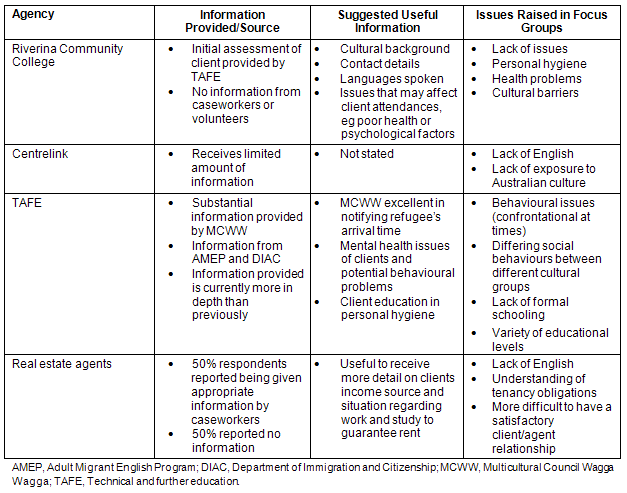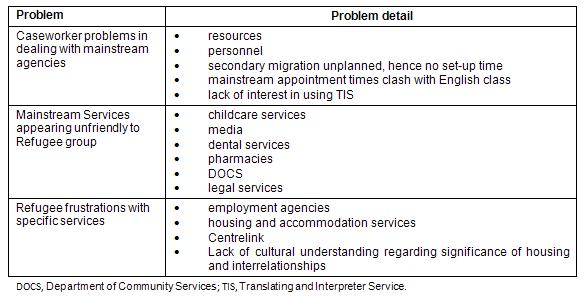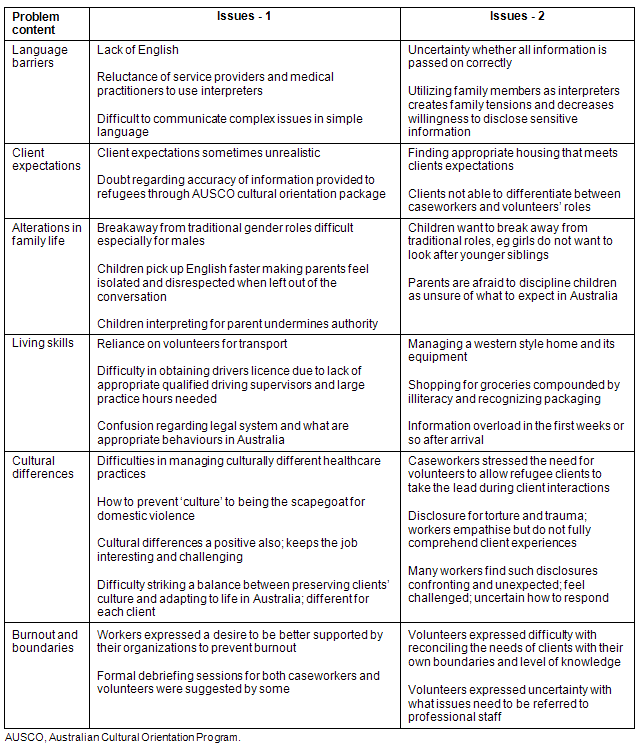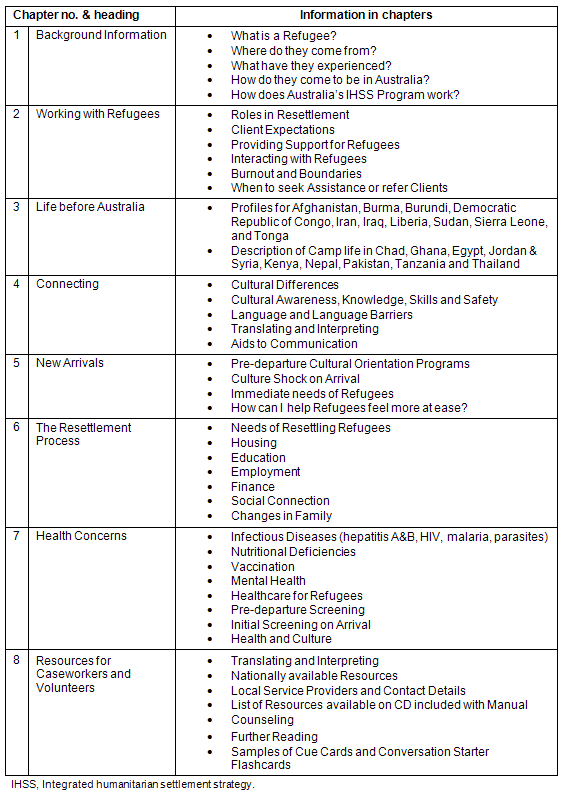Introduction
The Australian Government has encouraged increased regional settlement of refugees1, and the intention to regionally locate 45% of arriving refugees has been reported2. Commencing in the mid-1990s and increasing since 2005, Wagga Wagga, a New South Wales (NSW) regional city, has become a refugee destination for both primary and secondary migration under the Integrated Humanitarian Settlement Strategy (IHSS) and the Settlement Grants Program (SGP)3. Wagga Wagga has a population of 60 000 of which refugees comprise approximately 1%.
Backgrounds of disruption, torture, trauma and previous crowded camps or city life makes regional/rural relocation confronting for refugees, who require dedication and effort from those supporting resettlement2. Timely physical and psycho-social review and targeted intervention helps minimise interruption to settlement and is the goal of settlement agencies contracted to the IHSS.
However The Refugee Council of Australia (RCOA) voices concern about the effectiveness of current Australian systems for refugee resettlement4:
While rural and regional settlement has brought some welcome benefits for both refugee communities and the regional areas in which people have settled, there is a range of problems associated with service delivery and coordination of services that impact significantly on individuals and families.
Refugees arrive in Australia with vastly different cultures and beliefs, carrying traumatic life experiences unfamiliar to the wider Australian population. Their cultural identity is challenged by navigating a society with different beliefs and traditions from their own, learning a new language, adapting to new foods and learning new systems for health, welfare and education5. Refugees tackle these issues with coping mechanisms diminished by experiences of loss, grief, torture dislocation and family disruption5. The stress of resettlement can be eased by social connection and community ties to others of similar cultural background, which increases a sense of belonging and social identity6-8. Understanding these factors should be inherent in those involved in refugee resettlement.
In Australia, humanitarian entrants are assisted with settlement by community based and commercial service providers (SPs) contracted to the Department of Immigration and Citizenship (DIAC). The SPs are generally staffed by professional caseworkers and supported by volunteer organizations under the IHSS program9. However models of service provision differ, depending on organisational structures and locally available resources (Stage 1 of the present project). As training caseworkers and volunteers is the responsibility the individual SP, the provision and depth of training can vary greatly10.
It is widely acknowledged that volunteers play a crucial role in refugee resettlement9,10; therefore, as non-professional workforce it is vital that they are appropriately trained to work with people who may have intensive needs11,12. A paucity of research exists regarding the roles, needs and training of volunteers and caseworkers who work within IHSS settlement services. The development of a reference manual for settlement workers was therefore recommended.
Background of methods
The study was performed in two stages over 2 years, and was due to the dedicated efforts of two University of New South Wales (UNSW) medical students undertaking an independent learning project in year 4 of their course at UNSW's Rural Clinical School at the Wagga Wagga Campus.
Methods
A literature review was conducted at the outset of each stage using MEDLINE and PubMed, with manual searches of the Journal of Refugee Studies, Australian Family Physician (journal of the Royal Australian College of General Practice), and DIAC and RCOA websites. Search terms use in MEDLINE and PubMed databases were:
- immigration policy
- refugee; resettlement; rural
- rural and regional Australia
- caseworker; volunteer; IHSS
- manual; resources; publications.
Stage 1
Ager and Strang propose that successful resettlement and integration for refugees depends on access and achievement in 4 key domains: employment, housing, education and health12. Stage 1, therefore, analysed settlement services in NSW by reviewing and comparing the health systems available in two metropolitan (Canberra and Sydney) and two regional (Coffs Harbour and Wagga Wagga) services, concentrating on:
- service provision in rural and regional Australia
- healthcare provision, access and utilisation
- mainstream agencies
- resettlement and its effects on the social determinants of health.
Perspectives of mainstream agencies: Insights provided by mainstream agencies varied according to the extent of interaction with refugee clients, caseworkers and volunteers. All mainstream agencies identified language barriers as their major difficulty in working with refugee clients, and their lack of understanding of various systems such as tenancy and welfare work in Australia. Most agencies reported that they were provided with some prior background information about refugees, and that often this information was provided by IHSS caseworkers and volunteers. The background information provided to agencies interviewed, additional information they believed necessary to providing enhanced services to refugee clients, and other issues raised in focus groups are shown (Table 1).
Table 1: Issues raised by mainstream agencies in focus groups

Stage 2
Ethics approval was granted by the UNSW and Greater Southern Area Health Service. Stage 2 involved canvassing opinions regarding the usefulness and content of the proposed reference manual. Focus group and interview questions were developed according to findings from the literature review, with the aim to involve several groups of major refugee resettlement stakeholders in providing balanced feedback, and to facilitate development of a practical and relevant resource.
Resettlement service workers and mainstream service providers involved with refugees during the process of resettlement were recruited. Information pamphlets designed for each target group were provided to the managers of relevant services (including humanitarian entrants who had completed the IHSS program) for distribution to potential participants. Focus groups questions and self-report questionnaires were designed and, at the commencement of each focus group, participants signed consent forms for both the discussion and its audiorecording. If a participant did not consent to audiorecording, notes were handwritten.
All data were de-identified and analysed for common content and threads. One hundred participants contributed to the project over both stages via 19 focus groups, 14 semi-structured interviews and 8 self-report questionnaires.
While examining tools to assist caseworkers and volunteers in their work of refugee support, suggestions were noted in the literature that training provided to caseworkers should include an understanding of the migration process, experiences in transit, reasons for leaving the country of origin and how these factors affect family function. Questions used included reflections on prior education and training, unexpected issues arising in work with refugees, resources currently used, and suggestions for important material to be included in a manual.
The manual
The literature review gave direction to what should be included in such a manual:
- information on refugees and their experiences
- life in refugee camps
- information on torture and trauma and mental health issues
- needs of refugees on arrival
- cultural competence
- outline of the IHSS program.
The findings from all interviews consistently supported the concept of developing a manual, and participants recommended types of information and resources for inclusion. They emphasised that searching for and acquiring information was time-consuming and frustrating. It was reported that manuals were available but were often related to compliance with DIAC requirements, rather than providing information and resources helpful for resettlement workers.
Results
Stage 1
During focus groups, caseworkers raised several difficulties for refugees when dealing with agencies involved in resettlement. As a consequence, these also caused difficulties for caseworkers and volunteers (summarized in Table 2). These concerns included:
- inadequate funding/resources
- cross-service co-ordination
- liaison protocols within and external to the consortium
- planning for secondary migration
- short time-frame for IHSS (6 months) and impact on continuity of care
- local agencies held accountable for IHSS strategy shortfalls
- agency success being dependent on funding expertise within the organisation.
Table 2: Problems raised: mainstream agencies

A lack of sensitivity and understanding of the refugee needs, backgrounds and journeys was a common theme in Stage 1. This supported the need for a manual for reference and education of those working with refugees. Stage 2 of the project commenced on the basis of further needs and concerns raised by caseworkers and volunteers during focus groups.
Stage 2
Cultural: Volunteers requested more detailed information on the IHSS system, as well as background information on refugees, countries of origin and the nature of conflicts fled from. Some of the more experienced volunteers and caseworkers sought information on what to expect in working with refugees, highlighting that even a straightforward task such as taking a family to the doctor was usually complicated and therefore time-consuming. Volunteers from Coffs Harbour, in particular, suggested the inclusion of a range of strategies for working with refugees. Caseworkers identified that they may become de facto elders during resettlement, being expected to fulfil the traditional roles of community leaders. They highlighted the difficulty of establishing the boundaries in such situations.
Many focus group participants stressed that information on culture was important, in particular details about common countries of origin, information on social cues, differing taboos within cultures and life in refugee camps. They wanted a manual to highlight the need for resettlement workers to set aside their personal values and to allow the client to lead during interactions. Owing to the complexity of resettlement, it is important that all those who work with recently arrived refugees are sensitive to these concerns and address them within a culturally acceptable framework7,14. Where possible, suggestions were incorporated in the manual.
Practical tools: At almost every focus group it was stressed that the manual should be user-friendly and contain practical resources. Caseworkers in particular requested that the manual be simple to use and written in simple language. All participants reported that overcoming the language barrier posed considerable difficulty with new arrivals, compounded when refugees were illiterate in their own language. Because of this, pictorial tools were repeatedly suggested as a potential solution.
To address this request, tools were sourced from internet resources and other Australian agencies, and permission for reproduction obtained. Following extensive searches a large volume of material was obtained in commonly spoken refugee languages and pictorial form, and a decision was made to include a resources CD with the manual, rather than to provide a hard copy of each resource.
Volunteers requested that some useful phrases be developed to help break the ice and enable IHSS workers and refugees to learn about each other and each other's culture. Flash cards were developed to assist in initiating conversations, and designed to initiate curiosity about cultural and alternative values
System information: Several mainstream service providers had suggestions about inclusions for the manual, including service profiles of their organisations and information about the types of assistance they provided for refugee clients. Details of common services utilised were also found relevant by caseworkers and volunteers, such as details about and the length of English language programs. Technical and Further Education (TAFE) teachers requested that clients be made aware of standards of personal hygiene prior to commencing TAFE classes, so that broaching the subject of hygiene during class would not be unexpected or awkward for clients.
One issue arising from most focus groups with volunteers was that of being unfamiliar with local services and their locations. Lists of commonly utilised services (banks, real estate agencies, Centrelink, educational institutions, doctors' practices and specialists) were requested, with contact details. This was developed for local services in Wagga Wagga, and a template made available for use elsewhere. Caseworkers and volunteers had requested that the manual be locally relevant, yet adaptable for conditions in different areas.
Manual design
After analysing the content of focus groups issues, six broad areas were identified that gave direction in the construction of the manual:
- Language barrier
- Client expectations
- Alterations in family life
- Living skills
- Cultural differences
- Burnout and boundaries.
Practical problems in each of these areas expressed by participants are shown (Table 3). Many of the issues identified during focus groups reflected available literature, particularly difficulties faced by caseworkers and volunteers in addressing alterations in family structure and changing family roles6-8,13,14. Available, suitable housing for clients was universally reported by caseworkers and volunteers as problematic in both stages of the project (Table 4), and this was supported by literature from Australia and overseas9,12. Focus groups with humanitarian entrants reported that it was difficult to access housing due to a lack of rental history, and that houses were sometimes not of a desirable standard. One caseworker stated: 'Client expectations in terms of housing can differ from what they are given, which can cause a lot of frustration'.
Refugee expectations of housing were identified by caseworkers and volunteers as very high. The accuracy of information provided to refugees prior to arrival in Australia was questioned. A participant said:
Information that they get before they come over through AUSCO [Australian Cultural Orientation Program] isn't realistic. What I've seen in terms of what they produce in publications may not be totally realistic. Even what the refugees are saying, in terms of what they will get and what will happen, their expectations are very high.
Table 3: Practical problems as expressed by participants

Table 4: Barriers to housing

Several perspectives raised in the focus groups of humanitarian entrants differed from those of the caseworkers and volunteers. The humanitarian entrants said that it was vital that IHSS workers did not make assumptions about their clients. While it is true that many clients had limited English and experience of Western-style households, some humanitarian participants reported that they already had good English on arrival and had lived in Western-style houses prior to arrival in Australia. They reported that some questions asked by volunteers were embarrassing, such as being shown how to use household appliances and being asked, 'Have you used this before?' It is therefore clear that volunteers and caseworkers must establish their client's level of knowledge and tailor service delivery accordingly.
In both stages of the study humanitarian entrants reported several difficulties on first settling into Australia. Cultural differences, such as addressing elderly people by their first or given name in Australia, were hard when entrants were used to addressing older people with great respect. Entrants expressed concern that sometimes they had been given inaccurate information, indicating some substance to the statement from DIAC9 concerning the accuracy of information presented during the settlement period. Despite the difficulties of the initial settlement period, humanitarian entrants reported that they appreciated the way that volunteers and caseworkers had assisted them in many different ways since their arrival.
Based on such findings, sections of the manual were developed to address specific issues. Section headings reflected focus groups discussions, with sub-chapters expanding issues identified in the literature review. The ultimate chapter structure is shown (Table 5). Factsheets were also designed to be used with the manual and accessible via the Refugee Council of Australia's website.
Volunteers frequently expressed concerns about managing disclosures of previous torture and trauma. This was distressing for most workers and had the potential to cause considerable distress. It was therefore decided to include a section on stress management for settlement workers. The research team stressed that if a caseworker or volunteer became unsure or uncomfortable in any situation they should seek advice from a manager in their organisation.
Table 5: Manual chapter headings and content

Some suggestions for the manual were not able to be incorporated. For example, a request was made by volunteers for an organisational checklist to be included; however, researchers believed it was inappropriate for the manual to be a source of policy and procedure directives for IHSS workers, which may vary among IHSS agencies and change over time.
Conclusions and Recommendations
A refugee is defined15 as someone who:
...owing to well founded fear of being persecuted for reasons of race, religion, nationality, membership of a particular social group or political opinion, is outside the country of his nationality and is unable or...unwilling to...return to it.
Refugees are resettled into both rural and metropolitan locations across Australia, under the IHSS. The DIAC states that regional resettlement may provide improved outcomes for humanitarian entrants from a rural background, and that increasing settlement in regional Australia should contribute to long-term development of regional cities and towns, helping to address labour shortages faced by employers in rural Australia16.
The challenges posed by refugee resettlement are many, and caseworkers and volunteers frequently encounter issues that are difficult to anticipate. Every refugee arrives in Australia with a different experience and knowledge, and it is impossible to predict how the process of resettlement will proceed for each individual client.
At present, IHSS caseworkers are not provided with standardised training and the present research supports the need for training programs. While it is acknowledged that theoretical training cannot replace practical experience, background information is important to strengthen awareness of and confidence in managing the multiple issues inherent in refugee resettlement. Since this research, caseworker training has been commenced in one regional area.
A majority of participating volunteers attended training sessions. This is a positive finding and indicates that the concerns of DIAC and RCOA concerning the training and knowledge of volunteers may not be entirely warranted. It also highlights a lack of formal research into this area. Ideally, training should be provided prior to volunteers commencing work with refugees, although this will not always be possible due to the timing of training courses. That many volunteers would appreciate further training in a variety of areas indicates that training regimens may need greater depth.
Caseworker manual
A basic manual has been developed according to findings from available literature and in consultation with stakeholders in refugee resettlement. The manual further explores the issues highlighted in this report, and its limitations are acknowledged. There is a need for development of agency-specific resources that can provide directives to volunteers in particular, such as policy and procedure guidelines and checklists for activities such as household and neighbourhood orientation.
Multilingual and audiovisual resources on common topics (eg using banks, traffic safety and tenancy laws and obligations in NSW) would be extremely useful for caseworkers and volunteers, as well as for the refugees themselves. The responsibility for developing and distributing such resources is with relevant government departments; however, private organizations such as banks or real estate agencies may also address this need.
Further research
Further research into all aspects of refugee resettlement is much needed, especially with respect to settlement into rural regions of Australia. Many aspects of refugee resettlement are poorly explored in the literature (eg housing, employment, finances and education). Further exploration is also needed of the roles of caseworkers and volunteers in enabling refugees achieve resettlement milestones and ease their transition into Australian society. A follow-up study to assess the usefulness of the manual, as well as the need for further chapters, is warranted.
Refugees from all backgrounds have complex needs on arrival in Australia, including the need to become familiar with a new culture, learn English, find appropriate housing, enrol children in school, navigate new technologies and systems, as well as address complex physical and mental health issues6,12,14,17-23. Owing to the complexity of these issues it is important that all those who work with recently arrived refugees are sensitive to concerns and issues, and are able to address them in a culturally acceptable framework, with access to appropriate tools and resources.
Acknowledgements
The author thanks all organisations that assisted with the project and subsequent development of the manual, in particular: St Vincent de Paul, Wagga Wagga; Multicultural Council Wagga Wagga and Anglicare, Coffs Harbour, for their patience and willingness to assist. The author also acknowledges organisations that gave permission for their resources to be reproduced in the manual itself or on the resources manual's CD, including: Brimbank City Council, Victoria; Transcultural Mental Health Centre, Sydney South West Area Health Service; NSW Multicultural Health Communication Service; US Committee for Refugees and Immigrants; Eileen Pittaway, Director UNSW Centre for Refugee Research; Transcultural Services Unit, Eastern Health, Sydney; Professor John Murtagh, Monash University, Melbourne, Victoria; the Rural Clinical School, Faculty of Medicine, University of New South Wales, Wagga Wagga, NSW, Australia.
References
1. Department of Immigration, Indigenous and Multicultural Affairs. Report of the Review of Settlement Services for Migrants and Humanitarian Entrants. Canberra, ACT: DIMIA, 2003.
2. Campbell D. Regional settlement of refugees: implications for policing, refugee entrants and host communities, Briefing paper no3. Hobart, TAS: Tasmanian Institute of Law Enforcement Studies, 2007.
3. Australian Government Department of Immigration and Citizenship. Living in Australia: Integrated Humanitarian Settlement Strategy. (Online) 2010. Available: http://www.immi.gov.au (Accessed 7 October 2010).
4. Refugee Council of Australia. Australia's Refugee and Special Humanitarian Program: Current issues and Future Directions. (Online) no date. Available: http://www.refugeecouncil.org.au/current/index.html (Accessed 5 October 2010).
5. Benson J. Helping Refugees Integrate into Our Community - Reflections from General Practice. Australian Family Physician 2004; 33: 1-2.
6. Colic-Peisker V, Tilbury F. Employment niches for recent refugees: segmented labour market in twenty-first century Australia. Journal of Refugee Studies 2006; 19: 2.
7. Snyder C, May J, Zulcic N, Gabbard W. Social work with bosnian muslim refugee children and families: a review of the literature. Child Welfare 2005; 84: 5.
8. Barnes A. Community social support for Cuban refugees in Texas. Qualitative Health Research 2007; 17: 225.
9. Department of Immigration and Multicultural and Indigenous Affairs. Evaluation of the Integrated Humanitarian Settlement Scheme. (Online) 2003. Available: http://www.immi.gov.au/media/publications/pdf/evaluation_report.pdf (Accessed 5 October 2010).
10. Department of Immigration and Multicultural Affairs. Community support for refugees. a component of the Integrated Humanitarian Settlement Scheme. (Online) 2000. Available: http://www.immi.gov.au/media/publications/pdf/refugee_paper.pdf (Accessed 5 October 2010).
11. Refugee Council of Australia. Response to Australian Government Discussion Paper: 'Measures to Improve Settlement Outcomes for Humanitarian Entrants. (Online) 2006. Available: http://www.refugeecouncil.org.au/index.html (Accessed 8 July 2008).
12. Ager A, Strang A. Understanding integration: a conceptual framework. Journal of Refugee Studies 2008; 21: 2.
13. Fox P. Stress Related to family change among Vietnamese refugees. Journal of Community and Health Nursing 1991; 8: 1.
14. Pine B, Drachman D. Effective child welfare practice with immigrant and refugee children and their families. Child Welfare 2005; 84: 5.
15. United Nations High Commission for Refugees. Convention and protocol relating to the status of refugees. (Online) 1951. Available: http://www.unhcr.org/protect/PROTECTION/3b66c2aa10.pdf (Accessed 8 July 2008).
16. Department of Immigration and Citizenship. Australia's Support for Humanitarian Entrants 2004-05; Chapter 5 - Profile of People Assisted Under the IHSS 2004-05. (Online) 2005. Available: http://www.immi.gov.au (Accessed 8 July 2008).
17. Davidson N, Skull S, Burgner D, Kelly P, Raman S, Silove D et al. An issue of access: delivering equitable healthcare for newly arrived refugee children in Australia. Journal of Paediatrics and Child Health 2004; 40: 569-575.
18. Nyagua J, Harris A. West African refugee health in rural Australia: complex cultural factors that influence mental health. Rural and Remote Health 8: 884. (Online) 2008. Available: www.rrh.org.au (Accessed 5 October 2010).
19. Tiong A, Patel M, Gardiner J, Ryan R, Linton K, Walker K et al. Health issues in newly arrived African refugees attending general practice clinics in Melbourne. Medical Journal of Australia 2006; 185(11-12): 602-606.
20. Martin J, Mak D. Changing faces: a review of infectious disease screening of refugees by the Migrant Health Unit, Western Australia in 2003 and 2004. Medical Journal of Australia 2006; 185(11-12): 607-610.
21. Smith M. Refugees in Australia: changing faces, changing needs. Medical Journal of Australia 2006; 185(11-12): 587-588.
22. Clinton-Davis L, Fassil Y. Health and social problems of refugees. Social Science Medicine 1992; 35: 4.
23. Beiser M. Longitudinal research to promote effective refugee resettlement. Transcultural Psychiatry 2006; 43: 56-59.
